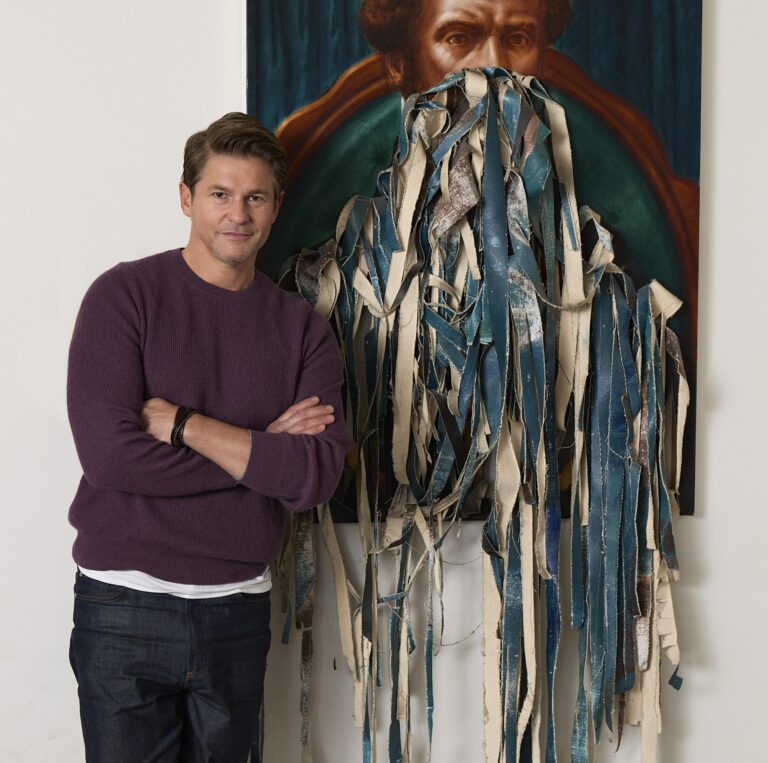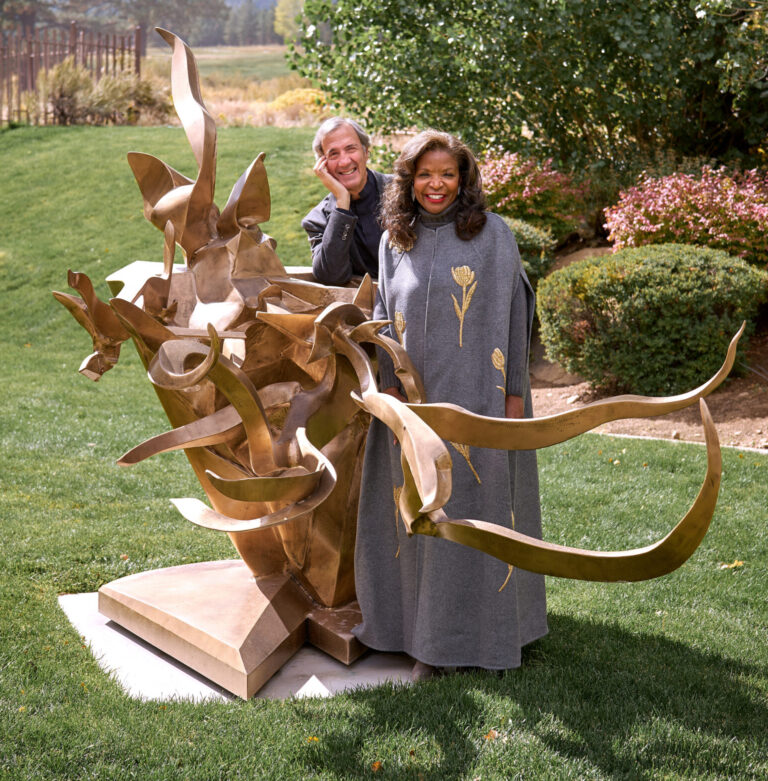
Puerto Rico’s preeminent art collector has an unexpected day job. A psychiatrist for nearly 40 years, César Reyes has been honing his visual instinct to assemble a roster of contemporary artists that rivals the world’s greatest private art museums. Along with his partner, Mima, Reyes has amassed a stunning breadth of talent—a large Rachel Feinstein or Yto Barrada here, a diminutive Jenna Gribbon or Radamés “Juni” Figueroa there. There's a deep commitment to women artists, such as Laura Owens, Elizabeth Peyton, Celia Paul, Zilia Sánchez, Issy Wood—the list goes on.
You can’t really talk about Puerto Rico’s artists or institutions without the Reyes name coming up as a generous cultural force on the island. For decades, their gravitas has garnered serious curatorial attention abroad with their collection frequently requested for exhibitions, earning them a spot on the esteemed ARTnews Top 200 Collectors list. Last year, for instance, they loaned a Gabriella Torres-Ferrer lamp post sculpture for the landmark Whitney exhibition "no existe un mundo poshuracán: Puerto Rican Art in the Wake of Hurricane Maria," which they subsequently donated to the museum’s permanent holdings.
But three ingredients set them apart from even the most astute collectors: their thirst to take the boldest of risks on young painters, their affection for and lifelong friendships with some of the generation’s biggest talents (from Turner Prize winners to McArthur Fellows), and often the hardest of all—their readiness to discuss how collectors budget, deliberate on prices, and accept when beloved artists unfortunately get too expensive.
On Calle de La Luna—Old San Juan’s most striking cobblestone street that gleams with riotous color—in an early 19th-century Spanish Colonial, their works on paper, canvases, and conceptual sculptures create a wondrous fiesta para la vista, captured in a recent photography shoot by the Puerto Rico artist Yiyo Tirado Rivera, whose work has been acquired by the Whitney. Here, Contributing Arts Editor Jacoba Urist steps inside the Reyes home for a tour of their celebrated collection.
As a physician, when did your art collecting journey begin?
César Reyes: In 1980, there was a major Pablo Picasso retrospective of almost 1,000 pieces of art at the Museum of Modern Art in New York. I had already started frequenting museums in Philadelphia where I was studying medicine. But that big Picasso show was a great influence. After seeing it, I started to visit places like the Barnes Foundation and to learn about conceptual art because the Philadelphia Museum of Art has a wing dedicated to Marcel Duchamp, and I stayed in Philadelphia for my psychiatry residency. I also met my friend, the Puerto Rico artist Rafael Ferrer, around 1980. That time really stands out to me because Rafael became an art world mentor too.




How do you think being a lifelong psychiatrist informs your connection to art?
César: I don’t really think it influences my collecting either way. They’re very different practices, having patients and looking at art. They are just two different experiences. Although, I would say that art has made it easier to tolerate some of the difficult patients that I have had in my profession. Being able to enjoy art and to be in the art world was a release for me. In that way perhaps, art has been adjunct to my psychiatry practice.
Who is the first artist you ever bought?
César: I was a medical student and obviously didn’t have a big budget. But there was a great small gallery [by] Janet Fleisher in Philadelphia. One day I went in—this was after the Picasso show at MoMA—and they had a 1961 Picasso lithograph, which I was able to buy very cheaply. It shows an open book with a flower coming out of its pages, and was used to raise money for a political and literary communist journal in France called Clarté. Picasso had been signing lithographs when Janet Fleisher visited his studio in the South of France. She acquired it, and then decided to sell it.
Shortly after, at the Philadelphia Museum of Art, I saw a work by Rafael Ferrer, who actually lived in Philadelphia. I heard he was having a show at Nancy Hoffman in New York on West Broadway. I went to it, and the 1981 drawing he made in oil crayon on a navigational map is the first contemporary artwork I acquired. I met Rafael, and as I mentioned we became close friends. I would go to New York and meet artist friends that he’d known for many years, like Alex Katz, Richard Serra, and Malcolm Morley.
Your collection spans numerous countries and mediums—but I don’t sense a particular theme or aesthetic that defines your taste.
César: A lot of artwork in our collection came through friendships with artists, and the artists are really the ones who have the eye. Through conversations with them, and some of their dealers, we became aware of works that were interesting to us. For example, in 1995 we met the artist Rirkrit Tiravanija in Berlin and had several talks together. Then, we were offered an artwork by him which was a pair of shoes that he had worn for a year. Mima and I had started to discuss whether we should pay the amount they were asking for a pair of shoes. That was one of the first times that I was actually confronted with the decision to buy a piece of conceptual art. Eventually, we did acquire the work. And this past fall and winter, it was on view at MoMA PS1’s show "Rirkrit Tiravanija: A LOT OF PEOPLE."
My favorite artwork in your home is the portrait by your friend, the Puerto Rican artist Enoc Perez, whose survey “The Island of Enchantment” at the Museo de Arte de Puerto Rico, was my pick for the strongest painting show of 2023.
César: We met Enoc in the late '90s when he was showing with the gallery Bronwyn Keenan in SoHo. We were able to connect with him and visit his studio, and have had a relationship ever since. The portrait you love is of my daughter Carola when we were building a pool at our home in Naguabo, Puerto Rico, which Jorge Pardo designed for us. Enoc also did a painting of us on the terrace upstairs, here in San Juan, as part of his series called "Someone Else’s Girlfriend"—women that he found beautiful, but already had somebody. In his series, the painting always has a woman and her partner, but you can only see an arm or a drink he’s holding. The man is present indirectly. He made a portrait, as a gift, of us that way—it’s of Mima—where you can only see my arm with a watch.

Let’s talk about the pink Carsten Höller sculpture in your home. How did you come to acquire such a captivating conversation starter?
César: The Carsten Höller hippo came up when we were actually in Monaco, visiting the parents of a dealer in Paris. The parents had a baby gorilla by the artist in their living room. It was really beautiful, and we wanted to acquire something like it. But the editions were finished, and nothing was available. So, we kept our eye on Carsten Höller’s work. He’s a scientist, and the series that our hippo comes from is one that he did of newborn animals. He has a baby alligator, a dolphin, and a rhinoceros. We were able to buy the hippo from a gallery in Germany.
I’m sure everyone who visits your collection wants to hear more about the wall protrusions off your kitchen.
César: Ah yes, the Martin Creed piece. We bought that from Martin’s gallery, Cabinet, in London. He’s a very conceptual artist as well, and one of my favorites. We just fell in love with the humor and the philosophy behind this sculpture. The manipulation of space makes it appear that the wall is swelling. There’s the allusion to female breasts. It’s a very complete work. We’ve developed a friendship with Martin, and he’s come to Puerto Rico to visit a few times.





As a couple, do you ever disagree about a piece of art you’re acquiring?
César: I am the one who usually initiates the process of buying something, and 99 percent of the time, I consult Mima. It’s more to discuss the prices than the work, because we share a similar vision. If it makes sense to her, and we can afford it, we’ll do it.
Mima: I totally trust his instinct about art. I think he’s more than proven that he has special calling, something that’s not common for most people. It might be an overused word, but it’s truly organic for him.
César: When we started, we didn’t consider ourselves collectors. We just liked the atmosphere of art, and the friendships we developed. It was more about a process and the spirit of the moment. There was no formality or calculation. It just flowed. We have never made lists of artists. We’re buying what we love, not because an artist is considered “hot.”
When I started out, I wanted to buy younger talents because the ones that I admired, like the artists of the School of London, had already developed their profession and were very expensive. I loved painting and there were a lot of painters in 1994, let’s say, just starting out. Some of them, I wish I could have afforded, like John Currin. But luckily I could afford painters like Peter Doig, or conceptual artists I’ve mentioned like Martin Creed, Rirkrit Tiravanija, and Jorge Pardo. It’s part of life that eventually artists will become famous and the prices will become ridiculously expensive. We know that’s a reality, so we try to buy the most we can afford.
What do you think is helping Puerto Rico’s artists finally receive their due on the global stage?
César: I really credit the wonderful curators we have now living outside of Puerto Rico and our artists in the last few years, people like Marcela Guerrero at the Whitney, and Carla Acevedo-Yates of the Museum of Contemporary Art Chicago. They have raised the level of curating, and brought the artists they love and identify with to their museums.
Mima: You also have Mari Carmen Ramírez at the Houston Museum of Fine Arts and Yasmil Raymond at the Städelschule in Frankfurt, and who’s been at MoMA, Dia, and the Walker.
César: Plus we have amazing curators in Puerto Rico—Marina Reyes Franco and Melissa Ramos Borges—and really wonderful, important galleries here like Embajada in Hato Rey and Kilometro in Santurce.

What are several of your most recent acquisitions and artists you are excited about right now?
César: Leilah Babirye is an incredible artist from Uganda, who shows with Gordon Robichaux. Another I’ve been buying from is Bridget Donahue, also in New York. We have several of the gallery’s artists now, like Martine Syms and Jessi Reaves. We have also recently acquired works by Ignacio Gatica, an artist from Chile who shows with Puerto Rican gallery Embajada, and a piece by Michael Linares with Kilometro.
Visiting your collection has a reputation for being both a visual and a culinary experience. (When I visited, Mima made incredible Chapin turnovers.) How did that come to be?
César: When we started to collect, Mima was very passionate about cooking. She eventually studied cooking professionally and became a chef. We would always have these incredible dinners here, and I think that had a lot to do with artists coming to visit us. They would love to spend the night here. Chris Ofili, Peter Doig, Jorge Pardo—they all watched the way Mima could make a party from one second to the next. Her culinary art became an essential part of our collecting.










 in your life?
in your life?

